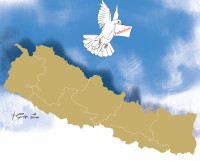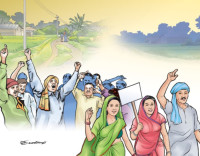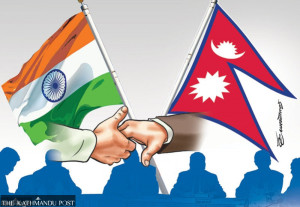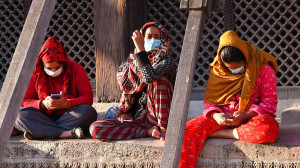Columns
Restoring squandered confidence
Institutions advising the government on climate remain disaster-reactive rather than climate proactive.
Madhukar Upadhya
We, as a nation, stand at a crossroads: Traditional political parties are losing their grip, while emerging ones have yet to establish a firm footing—at least until the upcoming elections. With parties scrambling to prove their relevance in this altered political landscape, marred by the intense internal churnings underway within each party, the erosion of public trust, at the bedrock of Gen-Z’s September revolt, overthrew a government that commanded a near two-thirds majority in the House.
This crisis did not erupt overnight; it is the culmination of over three decades of misgovernance, when the genuine, back-breaking hardships of ordinary citizens were not only ignored but often used as political pawns in the perpetual quest for power. Lack of employment, dwindling traditional livelihoods, exorbitant education and healthcare costs—exacerbated by deep distrust in government—left citizens sidelined. Instead of the accompanying glimmer of hope at the onset of every new government, they’d inevitably watch elites and their families reap the rewards of the political carousel, while the masses—especially the youth, who saw no viable future at home—endured the consequences.
While we’re accustomed to seeing high school graduates lining up for No Objection Certificates, eager to study abroad and chase opportunities elsewhere —a shared story of nearly every middle- or lower-middle-class family in the country—a Gen-Z leader’s words on the eve of the September protests struck a chord with its earnestness when he asked, “Do Nepali youth not get to grow old alongside our childhood friends in our own country?” It was indeed a watershed moment and a long-awaited response to decades of misrule.
Dwindling public trust
The overall governance issue may seem commonplace amid a world grappling with multiple crises—from escalating geo-economic tensions and soaring costs of living to unmet yet rising aspirations, shrinking foreign aid and an accelerating climate emergency. However, being citizens of one of the poorest countries and having to deal with these external stressors when our systems and institutions have been crippled and left hollow through decades of political wrangling and maladministration at home, has rendered the future exceptionally grim for youth from all walks of life.
Politics may take a different course, hopefully a clean one, in the aftermath of the elections, but how do we address the concurrent issues, including our precarious economy, which have been utterly neglected? Even if we sincerely commit to course-correcting, the big question is: Where do we begin? Creating jobs, building confidence and convincing the youth that a future is possible for them are herculean tasks with no quick fixes. Plans to improve the national Gross Domestic Product, which rarely reflects the conditions of ordinary people, won’t help in this regard. We must get back to basics and reflect deeply on what economic and livelihood matters truly affect millions of ordinary citizens.
The foundation of our economy—agriculture, the largest livelihood provider—presents a prime opportunity to rebuild public confidence through targeted reforms that help tackle decades-old challenges crippling the sector. Delving into the stressors, including climate impacts, exposes the dire threats to agriculture, where a single shock can plunge a prosperous farmer into poverty and desperation overnight.
Farmers have endured recurring droughts over the past 25 years, with frequency and duration escalating sharply since 2015 and becoming alarmingly routine since 2020. Mid-monsoon droughts, usually associated with long dry spells, have become normal. Winters have been rainless since 2022. Unseasonal heavy rains and floods have been damaging ready-to-harvest crops regularly. Droughts during the planting season and deluges at harvest time have left farmers stunned and unsure as to how they can adapt to such unreliable rainfall patterns. And, when the state continually fails to respond, it unravels the already frayed sociopolitical fabric of the country.
Weather-beaten economic foundation
These developments on the weather front have severely impacted our agriculture, rendering its future highly uncertain. The October rains of 2025, which destroyed ready-to-harvest paddy in Tarai and millet in the hills, laid bare these recurrent patterns once more. Over the past five years, these disasters have inflicted economic losses to the nation exceeding Rs100 billion, not counting the physical hardships and toll that people endured when damage to infrastructure hindered their daily lives. Following the October rain, Arun Roy, a farmer in Mahottari, lamented, “Farming can no longer sustain a livelihood here. My entire investment in this season’s paddy—planted with borrowed money—has been wiped out. Next year, I’ll leave the fields fallow instead.” For several decades, thousands like him have left their lands fallow over the back- and spirit-breaking work of farming.
The ever-widening gap between the increasing number of migrant workers and waning food production shows how agriculture has progressively become unreliable, raising questions about our food security. Anyone following the state of our food production perhaps wonders how on earth our food security is still sustained? It’s the rising food imports. No wonder our food import bill shot up from $1 billion in 2021 to $2.57 billion in 2024. But, therein lies the gamble: Places we import food from have also been plagued by similar problems. In India, where we import the bulk of our food from, over 2,000 farmers were quitting agriculture every day in the last two decades, indicating India’s own agrarian crisis.
One resilient field at a time
One viable path to extricate the nation from its present crisis lies in genuinely safeguarding agriculture—the lifeline of most of its citizens—against climate-induced stresses. Yet, the institutions, tasked with advising and directing the government on climate, remain disaster-reactive rather than climate proactive. Policy decisions have often been too little, too late and usually removed from reality. A recent example would be the 2021 Melamchi floods. Victims, still awaiting promised relief—including river embankments to protect farms and houses from future disasters—halted Melamchi water supplies to the capital in protest as a reminder to the government of its yet-to-fulfil commitment. Note that not every disaster victim can resort to such tactics of organised dissent to secure even minimal, timely assistance.
The solutions for climate-induced stresses on agriculture must be born of field-level exploration, tailored to local variations. However, nothing concrete has materialised in this regard except for a few pilot initiatives under the guise of ‘climate smart agriculture.’ We must begin to prioritise and integrate adaptation in all sectors to focalise climate in our development initiatives, including agriculture, to improve the economic base of ordinary citizens. This will enable them to act autonomously to deal with climate adversities as they have been doing throughout history, inadvertently ensuring our collective futures. The alternative only breeds resentment, fueling further unrest and uprisings as more farmers abandon agriculture without viable livelihood options in the coming years, amid a deepening climate crisis.




 20.12°C Kathmandu
20.12°C Kathmandu

.jpg&w=200&height=120)











%20(1).jpg&w=300&height=200)

